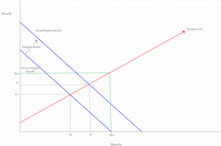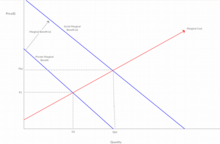Immunization
Immunization is the process by which an individual's immune system is strengthened against an agent (known as the immunogen).
When this system is exposed to molecules foreign to the body, called non-self, it will orchestrate an immune response, and will also develop the ability to respond quickly to a subsequent encounter due to immunological memory. This is a function of the adaptive immune system. Therefore, by exposing an animal to an immunogen in a controlled manner, its body can learn to protect itself: this is called active immunization.
The most important elements of the immune system that are enhanced by immunization are T cells, B cells, and the antibodies that B cells produce. Memory B cells and memory T cells are responsible for a rapid response to a second encounter with a foreign molecule. Passive immunization is the direct introduction of these elements into the body, rather than the production of these elements by the body itself.
Immunization is performed through various techniques, the most common being vaccination.[1] Vaccines against disease-causing microorganisms can prime the body's immune system, thus helping to fight or prevent infection. The fact that mutations can cause cancer cells to produce proteins or other molecules known to the body forms the theoretical basis for therapeutic cancer vaccines. Other molecules can also be used for immunization, for example, in experimental vaccines against nicotine (NicVAX) or the hormone ghrelin in experiments to create a vaccine against obesity.
It is often widely claimed that immunizations are less risky and an easier way to become immune to a particular disease than risk a milder form of the disease itself. They are important for both adults and children, as they can protect us from the many diseases that exist. Immunization not only protects children against deadly diseases, but also helps build children's immune systems. Through the use of vaccines, some infections and diseases have been almost completely eradicated in the United States and around the world. An example is polio. Thanks to dedicated health professionals and parents of children who got vaccinated on schedule, polio has been eliminated in the United States since 1979. Polio is still found in other parts of the world, so some people they may still be at risk of contracting it. This includes people who have never been vaccinated, who did not get all the doses of the vaccine, or who travel to areas of the world where polio is still present.
Active immunization/vaccination has been named one of the "Ten Great Achievements of Public Health in the 20th Century".
History
Before the introduction of vaccines, people could only be immune to an infectious disease by contracting the disease and surviving it. Smallpox was thus prevented by inoculation, which produced a milder effect than the natural disease. The first clear reference to smallpox inoculation was made by the Chinese author Wan Quan (1499-1582) in his Douzhen xinfa (痘疹心法) published in 1549. In China, powdered smallpox scabs were blown through the nose of the healthy. Patients would develop a mild case of the disease and have been immune to it ever since. The technique had a 0.5-2.0% mortality rate, but this was considerably less than the 20-30% mortality rate of the disease itself. The Royal Society of London received two reports on the Chinese practice of inoculation in 1700; one by Dr. Martin Lister, who received a report from an employee of the China-based East India Company, and another by Clopton Havers. According to Voltaire (1742), the Turks derived their use from inoculation of neighboring Circassia. Voltaire does not speculate on where the Circassians derived their technique from, though he reports that the Chinese have practiced it 'all these hundred years'. It was introduced to England from Turkey by Lady Mary Wortley Montagu in 1721 and used by Zabdiel Boylston. in Boston that same year. In 1798 Edward Jenner introduced inoculation with cowpox (smallpox vaccine), a much safer procedure. This procedure, known as vaccination, gradually replaced smallpox inoculation, now called variolation to distinguish it from vaccination. Until the 1880s vaccine/vaccination referred only to smallpox, but Louis Pasteur developed immunization methods for cholera in chickens and anthrax in animals and for human rabies, and suggested that the terms vaccine/vaccination be expanded to cover the new procedures. This can cause confusion if care is not taken to specify which vaccine is used, for example, the measles vaccine or the flu vaccine.
Passive and active immunization
Immunization can be achieved actively or passively: vaccination is an active form of immunization.
Active immunization
Active immunization can occur naturally when a person comes into contact with, for example, a microbe. The immune system will eventually create antibodies and other defenses against the microbe. Next time, the immune response against this microbe may be very efficient; this is the case in many of the childhood infections that a person only gets once, but is then immune.
Artificial active immunization involves injecting the microbe, or parts of it, into a person before they can assimilate it naturally. If whole microbes are used, they are pretreated.
The importance of immunization is so great that the American Centers for Disease Control and Prevention has named it one of the "Ten Great Achievements of Public Health of the 20th Century". Live attenuated vaccines have decreased pathogenicity. Its effectiveness depends on the ability of the immune system to replicate itself and causes a response similar to that of a natural infection. It is usually effective with a single dose. Examples of live attenuated vaccines include measles, mumps, rubella, MMR, yellow fever, varicella, rotavirus, and influenza (LAIV).
Passive immunization
Passive immunization involves transferring the pre-synthesized elements of the immune system to a person so that the body does not have to produce them on its own. Currently, the antibodies can be used for passive immunization. This method of immunization starts to work very quickly, but it is short-lived, because the antibodies break down naturally, and if there are no B cells to make more antibodies, the antibodies will disappear.
Passive immunization occurs physiologically, when antibodies are transferred from mother to fetus during pregnancy, to protect the fetus before and shortly after birth.
Artificial passive immunization is usually given by injection and is used if there has been a recent outbreak of a certain disease or as an emergency treatment for toxicity, such as tetanus. Antibodies can be produced in animals, called 'serum therapy', although there is a strong possibility of anaphylactic shock due to immunity against the animal serum itself. Therefore, humanized antibodies produced in vitro by cell culture are used instead, if available.
Economics of Immunizations
Positive externality
Immunizations impose what is known as a positive consumption externality on society. In addition to providing the individual with protection against certain antigens, it adds further protection to all other individuals in society through herd immunity. Because this extra protection is not accounted for in immunization market transactions, we see an underestimation of the marginal benefit of each immunization. This market failure is due to individuals making decisions based on their private marginal benefit instead of the social marginal benefit. Society's undervaluation of immunizations means that through normal market transactions we end up with less than the amount that is socially optimal.
For example, if individual A values his own immunity to an antigen at $100 but the immunization costs $150, individual A will choose not to receive the immunization. However, if the added benefit of herd immunity means that person B values person A's immunity at $70, then the total social marginal benefit of her immunization is $170. If the private marginal benefit of individual A is less than the social marginal benefit, there is an underconsumption of immunizations.
Socially optimal outcome
The fact that the private marginal benefits are less than the social marginal benefits will always lead to insufficient consumption of any good. The magnitude of the disparity is determined by the value that society places on each of the different immunizations. Many times, immunizations do not reach a socially optimal amount high enough to eradicate the antigen. Instead, they reach a social quantity that allows for an optimal number of sick individuals. Most commonly immunized diseases in the United States still have a small occurrence with occasional larger outbreaks. Measles is a good example of a disease whose social optimum leaves enough room for outbreaks in the United States that often lead to the deaths of a handful of individuals.
There are also examples of diseases so dangerous that the social optimum ended with the eradication of the virus, such as smallpox. In these cases, the marginal social benefit is so great that society is willing to pay the cost to achieve a level of immunization that makes the spread and survival of the disease impossible.
Despite the severity of certain diseases, the cost of immunization versus the marginal social benefit means that total eradication is not always the ultimate goal of immunization. Although it is difficult to say exactly where the socially optimal outcome is, we know that it is not the eradication of all diseases for which there is an immunization.
Internalizing the externality
To internalize the positive externality imposed by immunizations, payments equal to the marginal benefit must be made. In countries like the United States these payments are often made in the form of government subsidies. Prior to 1962, immunization programs in the United States were conducted at the state and local levels. Subsidy inconsistency caused some regions of the United States to reach the socially optimal amount, while other regions ran out of subsidies and remained at the private marginal benefit level of immunizations. Since 1962 and the Immunization Assistance Act, the United States as a whole has been moving toward the socially optimal outcome on a larger scale. Despite government subsidies, it is difficult to know when the social optimum has been reached. In addition to the difficulties determining the true societal marginal benefit of immunizations, we see cultural movements changing the private marginal benefit curves. Vaccine controversies have changed the way some private citizens view the marginal benefit of being immunized. If individual A believes that there is a great health risk, possibly greater than the antigen itself, associated with immunization, he or she will not be willing to pay for or receive immunization. With fewer willing participants and increasing marginal benefit, achieving a social optimum becomes more difficult for governments through subsidies.
In addition to government intervention through grants, nonprofit organizations can also move a society toward the socially optimal outcome by providing free immunizations to developing regions. Without the ability to afford immunizations to begin with, developing societies will not be able to achieve an amount determined by private fringe benefits. By running immunization programs, organizations can move underimmunized private communities toward the social optimum.
Contenido relacionado
Asparagine
In vitro fertilization
Chemotherapy





